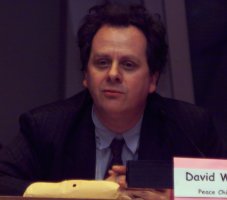 |
|
Side
Events for Wednesday 03 May
|
|
Environmental Protection and Land Use:How
are the States in the United States Integrating Environmental Protection
New Jersey, Minnesota and Pennsylvania and a few other states in
the United States have begun to more seriously integrate environmental
protection considerations into land use decisions. In the US, the
states have control over land use. This presentation reviewed what
Pennsylvania, New Jersey and Minnesota are doing to better integrate
environmental issues into land use decision making. Tools considered
included state land use plans, smart growth, model ordinances, protection
of important environmental areas, intensive use of geographical
information systems (GIS), the use of environmental models in decision
making, programs to support sustainable communities, sustainable
development indicators, operationalizing ecosystem and watershed
approaches.
|
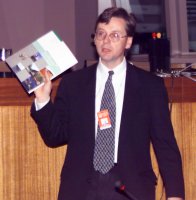 |
Michael
Bedrin, Chief
Counsel for the Pennsylvania Department of Environmental Protection,
said a panel
was established to find out what environmental issues will
be faced by Pennsylvania with two prominent results: Land use issues
were the most pressing problem; and the most important issue was
environmental education and environmental stewardship. He said local
officials need greater tools and greater education, as they are
not elected on a land use platform. He emphasized the need to revitalize
the urban areas to counter sprawl, and highlighted the Land Recycling
Program, which is a series of three statutes: changing rules for
cleaning up urban sites and put them back into productive use; uniform
cleanup standards and standardized review procedures; and release
of liability, a powerful incentive to put properties back into use.
He said, with the provision of financial assistance, 700 sites have
been cleaned up. He also highlighted the importance of data in decision
making and the need for identifying a set of environmental indicators.
|
|
Raymond
E. Cantor,
Assistant Commissioner for Land Use Management and Compliance, New
Jersey Department of Environmental Protection,
said New Jersey is known for having the most toxic waste sites and
is the most densely populated state in the United States. He said
development, particularly sprawl, is the primary factor that is
harming ecosystem problems He said people have not really thought
about the impact of this development on the environment. He drew
attention to getting all the information into the GIs system and
getting it out to the counties and that the problems that exist
must be recognized to begin with.In conclusion, he said that recognition
of environmental impacts is still in the early stages, regional
perspectives are beginning and upfront planning avoids problems
later.
|
 |
| Donald
A. Brown, Senior Counsel for Sustainable Development, Pennsylvania
Department of Environmental Protection, discussed the case of Minnesota.
He discussed the concept of "smart growth" which describes
the application of the sustainable developemnet concept to land use
issues. It means smart management of resources in both growing and
declining communities. Smart growth, like sustainable development,
is fiscally prudent and environmentally, economically and socially
sound while enhancing the choices people have for housing, jobs, recreation
and transportation. The long-term needs of people, business and the
environment ultimately define what is smart growth and sustainable
and what is not. He highlighted strong growth boundary system, with
circles around communities, and all growth inside these areas. He
said it has taken longer in the US than in European states to get
sustainable development moving into a new stage broader than sprawl.
integrate, env, econ and social planning at state level still losing
sprawl what would you like to see next tools with respect to env land
use. penn; better handle on data and what are actual conditions, He
highlighted the need to achieve a better level of knowledge through
further education of municipal and county officials. For more information
contact sustain@mnplan.state.mn.us
or visit www.mnplan.state.mn.us |
| Presentation of the Millennium Young People congress
outcome and launch of the Millennium Action Fund.
Peace Child International hosted
this side event, gathering panelists from UNICEF, UNDP,
UNEP, the Hague Appeal for Peace, the Trickle-Up
Program, and the UN Youth Unit. Individuals on the panel
spoke about their programs and experiences which engage and empower
youth. Underlying questions were addressed on the roles that youth
occupy, implementation of Chapter 25 of Agenda 21 to involve young
people in decision-making; obstacles to engaging youth, and how
international organizations, governments, NGOs and the private sector
can best form partnerships with young people. The event was attended
by youth delegates to the CSD-8, national government delegates,
UN agencies, and NGOs.
|
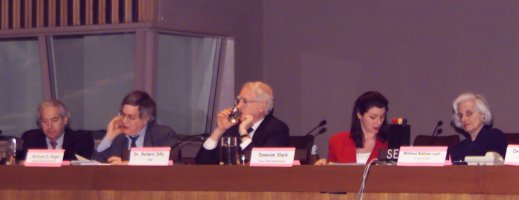
Photo (left to right) : Andres
Guerrero, UNICEF; William Angel, UN Youth Unit; Richard
Jolly, UNDP; Donovan Slack, Peace Child International; Mildred
Robbins Leet, Trickle-Up; Cora Weiss, Hague
Appeal for Peace; David Woollcombe, Peace Child
International.
|

Photo: William
D. Angel, Director, United Nations' Youth Unit (left); and Richard
Jolly, Special Adviser, UNDP (right). |
 William
D. Angel, UN Youth Unit : The sustainable development
of youth platforms is important to the UN, and many programs and
agencies have actively engaged youth in various ways. The establishment
of the UN Youth Fund, which disburses some $700,000 to
government ministries and youth organizations, has brought to
attention the need for understanding surrounding what Angel refers
to as "the sustainable development of youth platforms".
This refers to the need for youth organizations to provide accountability
and coherence with related programs at various levels of responsibility
and implementation. Angel notes that more rigorous scrutiny always
accompanies increases in funding and opportunities to engage youth
decision-making practices, and it its in the best interests of
the sustainability of youth organizations to be aware of these
requirements.
William
D. Angel, UN Youth Unit : The sustainable development
of youth platforms is important to the UN, and many programs and
agencies have actively engaged youth in various ways. The establishment
of the UN Youth Fund, which disburses some $700,000 to
government ministries and youth organizations, has brought to
attention the need for understanding surrounding what Angel refers
to as "the sustainable development of youth platforms".
This refers to the need for youth organizations to provide accountability
and coherence with related programs at various levels of responsibility
and implementation. Angel notes that more rigorous scrutiny always
accompanies increases in funding and opportunities to engage youth
decision-making practices, and it its in the best interests of
the sustainability of youth organizations to be aware of these
requirements.
|
|
Donovan Slack
of Peace Child International, described the organization's
education and partnership programs related to SD implementation,
focused on their program called the Millennium Action Fund
(MAF) – a fund that facilitates low-cost, youth-led SD projects
around the world. The organization solicits sponsorship and raises
funds for 288 international youth-created projects (Youth
Action Proposals) while providing infrastructure to support
these youth in the implementation of their projects. Projects
address environmental conservation, HIV/AIDS, public health,
water/sanitation, alternative energy, small-enterprise
development, primary education, new media/communications,
community development, peace, and refugees.
|
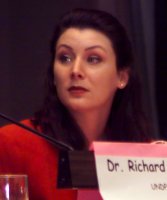
Moderator Donovan Slack,
Peace Child International.
|

Andres Guerrero, UNICEF. |
Andres
Guerrero, UNICEF, related that though UNICEF's programs are
largely influenced by the Convention on the Rights of the Child and
are centred on serving youth interests, the challenge remains as to
engaging youth in leadership roles. Out of 302 programs, all
report the involvement of youth action in various areas of
concentration such as civil society, children's rights, HIV/AIDS,
etc. yet only 12 report youth in head positions, and only 8 have
youth in analytical/problem-solving roles. The organization actively
seeks out new and innovative ways to balance these trends.
|
|
Dr. Noel Brown,
UNEP, an ardent supporter of youth participation, notes that we are
well beyond the point of definition... the challenge now is action.
Impressed with the Youth Action Proposals, young people are
identifying things that are within their spheres of expertise and
ability. Now the question remains as to the creation of mechanisms
to fund, support and engage youth projects on a regular basis. Dr.
Brown suggested that each UN agency and program should create youth
funding windows in order to provide such mechanisms of entrustment
for young people, as they are in a season of life full of creative
and valuable ideas.
|
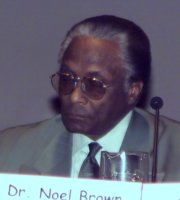
Dr. Noel
Brown, UNEP
|
|
|









